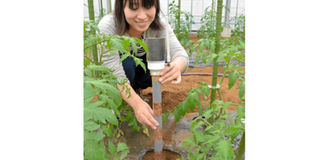Prime
Smart irrigation giving solutions to Japanese farmers

A member of SenSprout left, checks a water sensor produced by SenSprout at the University of Tokyo’s farm in Nishi-Tokyo city. Photo by Mari Fujisaki
A relatively inexpensive device could end millenniums of guesswork by farmers on how to grow their crops. A water monitoring system, developed by Tokyo-based venture SenSprout Inc., can save precious water resources, reduce costs and promote consistent growth of top quality produce.
Essentially, the system tells farmers how much water is in the soil for their crops.
The system was designed for dry climates where water is scarce and expensive, like in the central Indian city of Nagpur in Maharashtra state.There, two orange farms are taking part in an experiment to further develop the agricultural water monitoring system in collaboration with the Indian Institute of Technology. At each farm, a sensor is stuck into the ground of a 1-hectare field to check the amount of water held in the soil.
No more relying on guess work
Through the experiment, the team aims to refine the system so that it accurately informs farmers if their crops are adequately irrigated.
“About 70 per cent of the water used by human beings around the world is for farming,” said Kazuhito Mine, 38, representative director of SenSprout. “We are hoping to transform inefficient irrigation in agriculture, which has been relying on farmers’ intuitions, to avoid possible water shortages.”
The team plans to conduct similar experiments in three other regions in India and expand the project to the west coast of the United States. These areas receive little rainfall and require motorized pumps to tap into underground water for irrigation. This creates extra financial costs and environmental problems.
The project was financed through crowdfunding donations from 138 people around the world in 2015. In addition, the project won a monetary award of $150,000 in a venture startup competition to support entrepreneurs and new initiatives. With $169,931 (18 million yen), the team started research and development.
The sensor itself was developed by a research team led by Yoshihiro Kawahara, 38, an associate professor of information and communication engineering at the University of Tokyo. Kawahara also helped to establish SenSprout and acts as a technical adviser to the company.
The sensor is a tube-like object about 50 centimeters long.
Three patches of electrodes, consisting of resin film covered by a thin layer of copper, are placed on the part that goes into the soil. The electrodes sense the electrostatic capacity of the soil to reveal shifts in the amount of water held in the ground. It can tell how much water is absorbed by the plants’ roots.
The top part of the sensor has a wireless networking device that transmits the data to a smartphone placed nearby. The information is stored in an online cloud database, and farmers can remotely check the data on their computers or smartphones to see if their crops need more or less water.
Similar agricultural sensors have been produced, but they are mostly high-end pieces of equipment costing more than 500,000 yen ($4,630) for a set and are mainly used in data gathering by scholars and researchers. Few individual farmers have made such an investment. SenSprout’s sensor units, which consist of low-cost materials, such as resin pipes and copper film, each cost under 100,000 yen ($926) to produce.
The team is also conducting experiments around Japan with farmers who are seeking consistent quality in their produce. Yosuke Tamatsukuri, 38, who runs a farming business in Omitama, Ibaraki Prefecture, noticed that the sugar content level of his tomatoes differed from greenhouse to greenhouse.
He decided to install SenSprout’s sensors to monitor the condition of the soil and to fine-tune his watering method.
“The amount of water influences the growth of crops the most,” Tamatsukuri said. “Rather than irrigating crops by relying on intuition and experience, I want to be able to produce crops with the same quality every time.”
Asahi Shimbun, Japan




